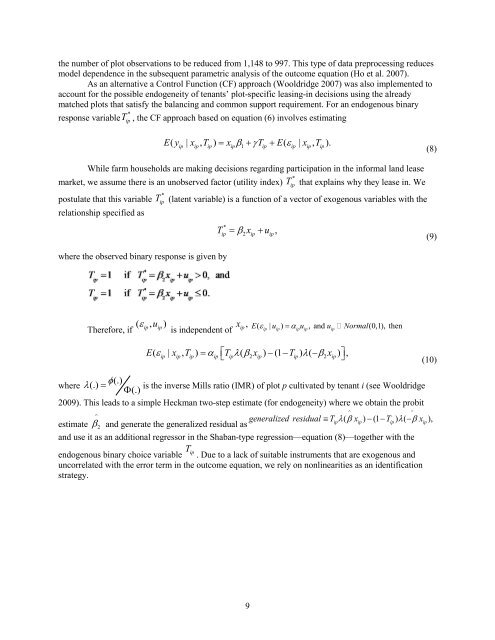Reverse-Share-Tenancy and Marshallian Inefficiency - International ...
Reverse-Share-Tenancy and Marshallian Inefficiency - International ...
Reverse-Share-Tenancy and Marshallian Inefficiency - International ...
You also want an ePaper? Increase the reach of your titles
YUMPU automatically turns print PDFs into web optimized ePapers that Google loves.
the number of plot observations to be reduced from 1,148 to 997. This type of data preprocessing reduces<br />
model dependence in the subsequent parametric analysis of the outcome equation (Ho et al. 2007).<br />
As an alternative a Control Function (CF) approach (Wooldridge 2007) was also implemented to<br />
account for the possible endogeneity of tenants’ plot-specific leasing-in decisions using the already<br />
matched plots that satisfy the balancing <strong>and</strong> common support requirement. For an endogenous binary<br />
*<br />
response variable , the CF approach based on equation (6) involves estimating<br />
T ip<br />
E( y | x , T ) = x β + γT + E( ε | x , T ).<br />
ip ip ip ip 1 ip ip ip ip<br />
(8)<br />
While farm households are making decisions regarding participation in the informal l<strong>and</strong> lease<br />
*<br />
market, we assume there is an unobserved factor (utility index) that explains why they lease in. We<br />
postulate that this variable<br />
relationship specified as<br />
*<br />
T ip<br />
where the observed binary response is given by<br />
T ip<br />
(latent variable) is a function of a vector of exogenous variables with the<br />
T x u<br />
*<br />
ip<br />
= β2 ip<br />
+<br />
ip,<br />
(9)<br />
Therefore, if<br />
( ε<br />
ip, uip<br />
)<br />
x<br />
ip,<br />
E( εip | uip ) = αipuip, <strong>and</strong> uip<br />
Normal(0,1), then<br />
is independent of<br />
E( εip | xip , Tip ) = α ⎡<br />
ip ⎣Tip λβ (<br />
2xip ) −(1 −Tip ) λ( −β2xip<br />
) ⎤<br />
⎦,<br />
(10)<br />
where λ (.) =<br />
φ(.)<br />
is the inverse Mills ratio (IMR) of plot p cultivated by tenant i (see Wooldridge<br />
Φ(.)<br />
2009). This leads to a simple Heckman two-step estimate (for endogeneity) where we obtain the probit<br />
^<br />
generalized residual ≡Tipλβ ( xip ) −(1 −Tip ) λ( −βxip<br />
),<br />
estimate β 2 <strong>and</strong> generate the generalized residual as<br />
<strong>and</strong> use it as an additional regressor in the Shaban-type regression—equation (8)—together with the<br />
T ip<br />
endogenous binary choice variable . Due to a lack of suitable instruments that are exogenous <strong>and</strong><br />
uncorrelated with the error term in the outcome equation, we rely on nonlinearities as an identification<br />
strategy.<br />
^<br />
^<br />
9
















